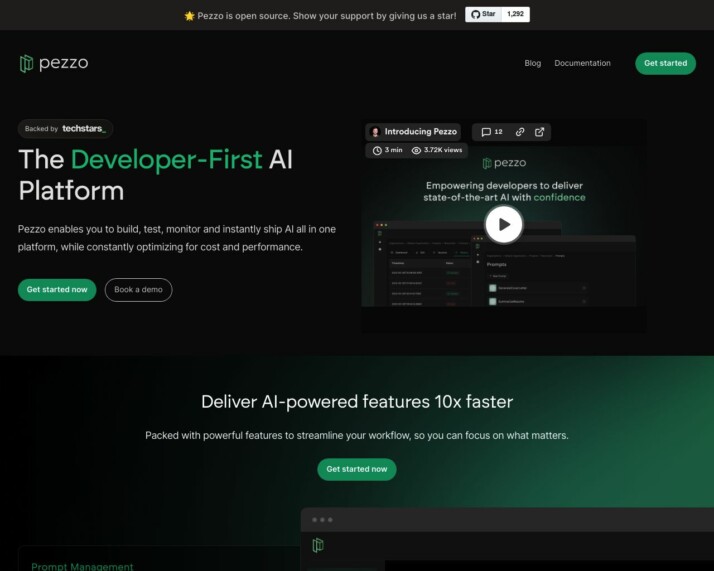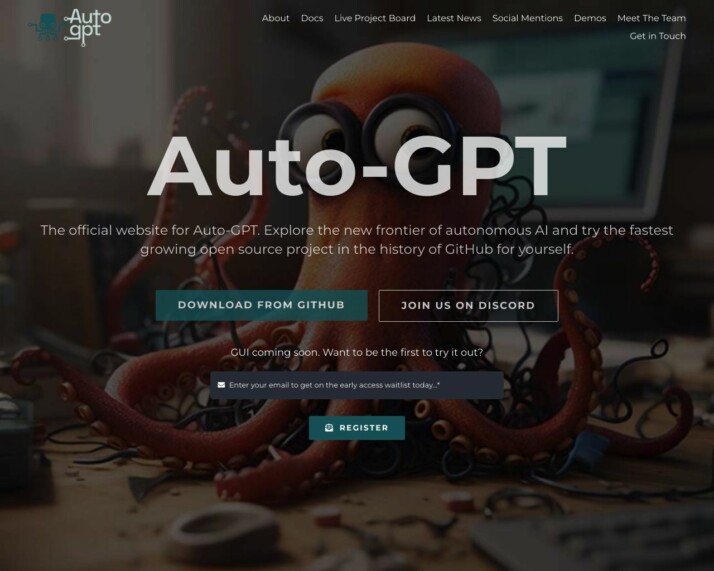Table of Contents
Introduction
Are you curious about the world of AI-driven development tools and keen on understanding how they can influence your work? Let’s introduce you to two robust platforms that are making considerable strides in this area – Pezzo and AutoGPT.
Pezzo is an open-source toolkit designed to streamline and simplify the process of AI development. It particularly focuses on prompt management and deployment. It bolsters efficiency in AI operation, emphasizing ease of use, making it particularly appealing to developers and teams seeking to integrate AI models into their applications.
Pezzo is loaded with an array of features encompassing centralized prompt management, a streamlined design, instant deployments, and observability. It provides a platform that not only supports multiple clients but also offers deployment flexibility. On the other hand, we have AutoGPT.
This platform is a sophisticated amalgamation of AI technology. It leverages the power of Large Language Model (LLM) applications by orchestrating multi-agent conversations, allowing for both autonomous task completion and human-assisted feedback loops. AutoGPT finds its stronghold in enhanced inference capabilities and customizable agents.
It fosters an environment conducive for complex problem-solving, automated code generation, and continual learning. In essence, both Pezzo and AutoGPT cater to a wide range of audience needs.
While Pezzo focuses on streamlining the AI development process, AutoGPT steps into enhancing the application of Larger Language Models through conversational inputs. As we delve deeper into the subsequent sections, we will further explore the detailed features, user cases, and benefits of these powerful platforms. Join us in this enriching journey.
An Overview of Pezzo: Simplifying AI Development
Developed as an open-source platform, Pezzo serves as a comprehensive solution for AI development. Its primary function is to streamline the process of managing and deploying AI prompts. So, what’s a prompt? Imagine instructing an AI model to perform a task – the instruction you give is what we call a prompt!


Pezzo spotlights some unique features that ensure efficiency and ease of use:
- Centralized Prompt Management: It offers a one-stop platform to manage all your AI prompts. Think of it as a control center for all your AI instructions.
- Streamlined Prompt Design & Versioning: You get to create, test, and control versions of your prompts in a simplified manner – hassle-free!
- Instant Deployments: Get to publish prompts instantly, speeding up your deployment process.
- Observability and Monitoring: Gather detailed insights on prompt execution, troubleshoot problems, and continuously improve your AI model’s performance.
- Cost Transparency: It offers clear visibility into the costs associated with different prompts and AI models.
- Multiple Client Support: It supports both Node.js and Python, adding more flexibility to integrate with different programming environments.
- Deployment Flexibility: It allows you to deploy in different environments, with clear version control and rollback options.
Pezzo’s vision lies in democratizing AI deployment and development, making the process more accessible and manageable. So, whether you are a novice or an experienced developer exploring AI capabilities for your applications, Pezzo is here to make your journey smoother and more efficient.
AutoGPT: An Innovative AI Solution
For those at the forefront of AI innovation, such as researchers or tech startups, AutoGPT is a unique AI-driven tool. Developed for technically proficient users who require AI capabilities such as robust data analysis and content management, AutoGPT offers cutting-edge functionalities, making it a game-changer in the rapidly evolving AI field.
Its unique offerings include BabyAGI, a product characterized by autonomous task generation and execution. Based on objectives set by users, BabyAGI automates task management, reducing the cognitive load on users and freeing them up for high-level tasks. This feature makes it particularly beneficial for larger organizations in need of custom AI solutions.


AutoGPT takes pride in its advanced AI technologies, such as the utilization of OpenAI’s GPT-4, a state-of-the-art large language model (LLM), and the integration of Pinecone’s vector search engine. Its ability to handle various types of data inputs including text and images, coupled with its capability to autonomously perform complex tasks, makes AutoGPT a versatile AI solution that aligns with its vision of reducing human intervention.
Its recent shipments are primarily built upon the GPT-4 and GPT-3.5 models, highlighting its commitment to using advanced AI technology. While the absence of a cloud-hosted SaaS model suggests that AutoGPT doesn’t qualify as providing ‘hosted agents’, it does support distinct development and production setups, as indicated by its compatibility with Docker and Python environments.
To sum up, AutoGPT brings autonomous AI solutions to the table in the form of BabyAGI and its own AI solution integrating open-source components. While there are areas left to explore such as hosting agents and providing a no-code solution, AutoGPT’s current features, target audience, and vision make it a promising player in the AI industry.
Comparing the Features of Pezzo, AutoGPT, and SmythOS
When choosing an AI for your business needs, it’s essential to understand the features each platform provides. Today, let’s compare the most sought-after options available in the market for Large Language Model users – Pezzo, AutoGPT, and SmythOS.
| Features | Pezzo | AutoGPT | SmythOS |
|---|---|---|---|
| HostedAgents(Dev,Production) | ❌ | ❌ | ✅ |
| Environments(Dev,Production) | ✅ | ❌ | ✅ |
| VisualBuilder | ❌ | ❌ | ✅ |
| No-CodeEditor | ❌ | ❌ | ✅ |
| Memory&Context | ❌ | ✅ | ✅ |
| AutonomousAgents | ❌ | ✅ | ✅ |
| ExplainabilityandTransparency | ❌ | ❌ | ✅ |
| DebugMode | ✅ | ❌ | ✅ |
| Multimodal | ❌ | ❌ | ✅ |
| Problem-SolvingCapabilities | ✅ | ✅ | ✅ |
Differences in features between these platforms can significantly impact the end-user experience. Pezzo’s strong points include environment setups for both development and production as well as in-built debug mode.
However, it lacks in offering advanced AI features like memory & context understanding, and autonomous agents. These absences could affect complex problem-solving scenarios and reduce the platform’s ease-of-use.
AutoGPT, on the other hand, excels in providing the advanced features Pezzo doesn’t. It has memory and context features, and also offers the capability for autonomous agents.
The lack of a debug mode would require extra caution during system development and could increase troubleshooting time. The decision between Pezzo and AutoGPT would boil down to the user’s specific project requirements and their comfort with debugging.
The Intended Audience and End Users for Pezzo and AutoGPT
Intended Audience:
Software Developers and Engineers: The capability to develop complex software, including CRUD code, data analysis jobs, and Python games, directly appeals to software developers. The automated code generation and quality compliance features would be particularly valuable for engineers looking to streamline their workflow.
Project Managers and Product Managers: The framework’s ability to manage entire software development projects from conception to QA would benefit project and product managers. The specialized agent roles like product manager agents and project manager agents suggest that MetaGPT is designed to complement and enhance project management tasks.
Startups and Entrepreneurs: The feature that allows setting up a software company with a single prompt makes it especially attractive for startups and entrepreneurs looking to minimize operational complexities and resource allocation for software development.
Companies Looking for Automation Solutions: Organizations seeking to automate their software development processes would find MetaGPT’s comprehensive automation approach beneficial. The system’s scalability and ability to handle complex tasks make it suitable for companies of various sizes looking to optimize their software development lifecycle.
Technology Innovators and Experimenters: MetaGPT’s novel use of multi-agent collaboration and its global memory pool feature would appeal to innovators and experimenters in the tech industry who are constantly seeking cutting-edge solutions and efficiencies.
AI and Machine Learning Enthusiasts: Given its foundation in large language models and advanced AI capabilities, MetaGPT would also cater to AI and machine learning enthusiasts interested in exploring new applications of AI in software development.
End Users with Specific Goals: Individuals or professionals who need assistance with planning, studying, or business development can use these AI agents to automate tasks related to their goals.
Educators and Students: Agents like Calculus GPT suggest a focus on academic assistance, making the platform suitable for educational purposes.
Business Professionals: The Hustle GPT agent, designed for creating reports on business growth, indicates a utility for entrepreneurs and business strategists.
Pezzo – Streamlining AI Development
Centralized Prompt Management: A unified platform for managing all AI prompts, enhancing visibility and efficiency.
Streamlined Prompt Design & Versioning: Simplified creation, editing, testing, and versioning of prompts.
Instant Deployments: The ability to publish prompts instantly without a full release cycle, accelerating the deployment process.
Observability and Monitoring: Detailed prompt execution history, statistics, and metrics are accessible, aiding in better insights and troubleshooting.
Cost Transparency: Comprehensive visibility into the costs associated with different prompts and AI models.
Multiple Client Support: Pezzo supports both Node.js and Python, indicating versatility in terms of integration with different programming environments.
Deployment Flexibility: Ability to deploy in different environments, particularly in production, with clear version control and rollback options.
AutoGPT – Developing Large Language Model Applications
Multi-Agent Conversations: AutoGPT’s core feature is its ability to facilitate conversations between multiple agents. These agents can collectively perform tasks autonomously or with human feedback, making it highly adaptable for different use cases.
Enhanced LLM Inference: It maximizes the performance of LLMs like ChatGPT and GPT-4 by offering enhanced inference capabilities. This includes functionalities like tuning, caching, error handling, and templating, which are crucial for optimizing the utility of expensive LLMs.
Customizable and Conversable Agents: Agents in AutoGPT are not only conversable but also customizable. This allows developers to tailor the agents according to the specific needs of the task, integrating LLMs, human inputs, and various tools.
Autonomous Operations with Human Feedback: AutoGPT supports both fully autonomous agent operations and human-in-the-loop problem-solving. This flexibility is significant for applications where human input is essential.
Application Diversity: The framework is demonstrated to be effective in a wide range of applications, from automated task-solving and code generation to continual learning and complex problem-solving in group chats.
Conclusion
Pezzo and AutoGPT are both powerful AI development toolkits that cater to different audiences and offer unique features. Pezzo is primarily designed for developers and development teams who are actively engaged in AI application development.
Its focus on streamlining the AI development process, ensuring cost efficiency, and providing robust management tools aligns well with the needs of professionals in the rapidly evolving field of AI.
On the other hand, AutoGPT caters to innovators in the AI space, including software developers, tech-savvy businesses, and organizations looking to leverage AI for complex and innovative applications.
Pezzo’s standout features include centralized prompt management, streamlined prompt design and versioning, instant deployments, observability, monitoring, and cost transparency. It supports multiple clients, such as Node.js and Python, and offers deployment flexibility in different environments.
However, there is no specific information about Pezzo’s scalability, hosted vector database, sitemap crawler, YouTube transcript crawler, URL crawler, PDF support, or word and text file support.
AutoGPT, on the other hand, stands out for its integration with advanced GPT models, its multimodal capabilities, autonomous functionality, problem-solving skills, audit logs, and API deployment. It offers a sophisticated framework for developing Large Language Model (LLM) applications with multi-agent conversations. The framework’s ability to facilitate conversations between multiple agents and its support for human-AI interaction make it highly adaptable for various use cases.
Both Pezzo and AutoGPT have their strengths and target different audiences. Pezzo focuses on providing a user-friendly and goal-directed AI platform for developers, development teams, and organizations prioritizing efficiency and cost management. On the other hand, AutoGPT caters to technologically proficient users seeking to leverage AI for complex and innovative applications. Ultimately, the preference between the two will depend on the specific needs and goals of the users.
When considering the comparison with SmythOS, SmythOS emerges as the favored choice. SmythOS offers a comprehensive and intuitive AI development environment that combines the best features of Pezzo and AutoGPT, catering to developers, development teams, and organizations of all sizes. Its advanced capabilities, seamless integration with various AI models, and emphasis on usability and efficiency set it apart as the superior choice in the AI development landscape.
Last updated:
Disclaimer: The information presented in this article is for general informational purposes only and is provided as is. While we strive to keep the content up-to-date and accurate, we make no representations or warranties of any kind, express or implied, about the completeness, accuracy, reliability, suitability, or availability of the information contained in this article.
Any reliance you place on such information is strictly at your own risk. We reserve the right to make additions, deletions, or modifications to the contents of this article at any time without prior notice.
In no event will we be liable for any loss or damage including without limitation, indirect or consequential loss or damage, or any loss or damage whatsoever arising from loss of data, profits, or any other loss not specified herein arising out of, or in connection with, the use of this article.
Despite our best efforts, this article may contain oversights, errors, or omissions. If you notice any inaccuracies or have concerns about the content, please report them through our content feedback form. Your input helps us maintain the quality and reliability of our information.
Alexander De Ridder
Co-Founder, Visionary, and CTO at SmythOS. Alexander crafts AI tools and solutions for enterprises and the web. He is a smart creative, a builder of amazing things. He loves to study “how” and “why” humans and AI make decisions.
Explore All Comparison Articles
Decisions vs. Sola: AI Workflow Automation Showdown
AI-powered workflow automation platforms revolutionize how businesses streamline operations and boost productivity. This comparison explores Decisions vs. Sola, and SmythOS,…
DeepOpinion vs. Sola: Comparing AI Automation Platforms
AI-powered automation platforms revolutionize business operations, but choosing the right solution can be challenging. This comparison of DeepOpinion vs. Sola,…
DevGPT vs. Sola: AI-Powered Development Tools Compared
AI-powered development tools revolutionize software creation, offering unprecedented efficiency and capabilities. This comprehensive review compares DevGPT vs. Sola, and SmythOS,…
Fine AI vs. Sola: Comparing AI Automation Tools
AI-powered automation transforms software development and business workflows, offering unprecedented efficiency and innovation. Fine AI vs. Sola present distinct approaches…
FlowiseAI vs. Sola: Comparing AI Automation Platforms
AI-powered automation revolutionizes business operations, driving efficiency and innovation across industries. FlowiseAI vs. Sola offer distinct approaches to harness this…
Gooey AI vs. Sola: AI-Powered Automation Platforms Compared
AI-powered automation platforms revolutionize how businesses streamline operations and enhance productivity. This comparison delves into Gooey AI vs. Sola, two…

